347th Rescue Group
The United States Air Force's 347th Rescue Group is an active combat search and rescue unit assigned to the 23d Wing at Moody Air Force Base, Georgia.
| 347th Rescue Group | |
|---|---|
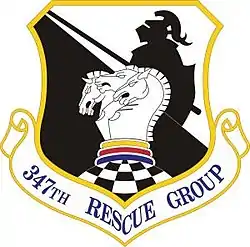 Emblem of the 347th Rescue Group | |
| Active | 1942–1946 1947–1950 1991–present |
| Country | United States |
| Branch | United States Air Force |
| Part of | 23d Wing |
| Garrison/HQ | Moody AFB, Georgia |
| Engagements |
|
| Decorations | |
| Commanders | |
| Notable commanders | Victor E. Renuart Jr. |
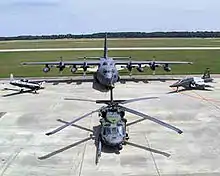
Mission
The 347th Rescue Group directs flying and maintenance of the one of two USAF active-duty Groups dedicated to Combat Search and Rescue. Responsible for training/readiness of 1,100 personnel, including a pararescue squadron, two flying squadrons (Lockheed HC-130/HH-60 Pave Hawk), and an operations support squadron. Deploys worldwide in support of National Command Authority taskings.
Units
- 38th Rescue Squadron
The 38th Rescue Squadron trains, equips, and employs combat-ready pararescue and supporting personnel worldwide in support of U.S. national security interests and NASA. This squadron provides survivor contact, treatment, and extraction during combat rescue operations, and uses various fixed/rotary wing insertion/extraction assets and employs by any means available to provide combat and humanitarian search, rescue, and medical assistance in all environments. - 41st Rescue Squadron
The 41st Rescue Squadron maintains combat-ready status as an HH-60G Combat Search and Rescue (CSAR) and Personnel Recovery (PR) squadron. This squadron specializes in combat rescue of downed aircrews using night vision goggles (NVG), low-level formation, forward looking infrared cameras, aerial refueling, and survivor recovery. Members assigned to this squadron rapidly mobilize, deploy, and employ to provide combat and peacetime search and rescue in support of US national security interests and the NASA Space Shuttle. The 41st Rescue Squadron has all-weather, all-environment capabilities.[1] - 71st Rescue Squadron
The 71st Rescue Squadron maintains combat-ready status with 11 aircraft as one of two active duty HC-130J, combat search and rescue (CSAR) squadrons. This squadron rapidly mobilizes, deploys, and executes CSAR operations worldwide in support of national security interests. This mission requires the squadron to conduct low-level operations and air refueling using night vision goggles (NVGs) and airdrop pararescue personnel in support of combat personnel recovery. - 347th Operations Support Squadron
The 347th Operations Support Squadron supports all warfighting operations associated with the Host Rescue Wing and ongoing deployments in support of U.S. National interests, while developing, mentoring, and training leaders and productive members to ensure spectacular Air Force success.
History
- For additional lineage and history, see 347th Rescue Wing
Lineage
- Established as 347th Fighter Group on 29 September 1942
- Activated on 3 October 1942
- Inactivated on 1 January 1946
- Redesignated 347th Fighter Group (All Weather) on 19 December 1946
- Activated on 20 February 1947
- Redesignated: 347th Fighter Group, All Weather, on 10 August 1948
- Redesignated: 347th Fighter-All Weather Group on 20 January 1950
- Inactivated on 24 June 1950
- Redesignated: 347th Tactical Fighter Group on 31 July 1985 (Remained inactive)
- Redesignated: 347th Operations Group on 1 May 1991
- Activated on 1 May 1991
- Redesignated: 347th Rescue Group on 1 October 2006.
Assignments
|
|
Components
- 4th Fighter (later, Fighter-All Weather) Squadron: 20 February 1947 – 24 June 1950 (detached entire period)
- 38th Rescue Squadron: 1 May 2001–present
- 41st Rescue Squadron: 1 April 1997–present
- 52d Airlift Squadron: 1 May 1994 – 16 September 1997
- 67th Fighter Squadron: 3 October 1942 – 1 November 1945
- 68th Fighter (later, Fighter-All Weather; Tactical Fighter; Fighter) Squadron: 3 October 1942 – 1 November 1945; 20 February 1947 – 24 June 1950 (detached 1 March – 24 June 1950); 1 May 1991 – 30 April 2001
- 69th Tactical Fighter (later, Fighter) Squadron: 1 May 1991 – 2 February 2001
- 70th Fighter (later, Tactical Fighter; Fighter) Squadron: 3 October 1942 – 30 March 1943; 1 November – 26 December 1945; 1 May 1991 – 30 June 2000
- 71st Rescue Squadron: 1 April 1997–present
- 339th Fighter (later, Fighter-All Weather) Squadron: 3 October 1942 – 1 January 1946; 20 February 1947 – 24 June 1950 (detached 1 July 1949 – 24 June 1950)
- 307th Fighter Squadron: 20 November 1992 – 31 August 1995
- 308th Fighter Squadron: 20 November 1992 – 1 April 1994
- 431st Fighter Squadron: attached 15 November 1947 – 28 August 1948
- 433d Fighter Squadron: attached 18 November 1947 – 28 August 1948.
Stations
|
|
Aircraft
|
|
World War II
Constituted as the 347th Fighter Group on 29 September 1942. Activated in New Caledonia on 3 October 1942. Detachments of the group, which was assigned to Thirteenth Air Force in January 1943, were sent to Guadalcanal, where they used Bell P-39 and P-400 Airacobra aircraft to fly protective patrols, support ground forces, and attack Japanese shipping.
Operational squadrons of the 347th FG were the 67th, 68th, 70th and 339th Fighter Squadrons.
When the Allied campaign to recover the central and northern Solomon Islands began in February 1943, the detachments, still operating from Guadalcanal and using Lockheed P-38 Lightnings and P-39 Airacobras, escorted bombers and attacked enemy bases on New Georgia, the Russell Islands, and Bougainville.
It was P-38Gs of the 339th Fighter Squadron which, on 18 April 1943, flew the mission which resulted in the death of Japanese Admiral Isoroku Yamamoto. Only their aircraft possessed the range to intercept and engage. Pilots were informed that they were intercepting an "important high officer," although they were not aware of who their actual target was.
On the morning of 18 April, despite urgings by local commanders to cancel the trip for fear of ambush, Yamamoto's planes left Rabaul as scheduled. Shortly after, eighteen specially fitted P-38s took off from Guadalcanal. They wave-hopped most of the 430 miles to the rendezvous point, maintaining radio silence throughout. At 09:34 Tokyo time, the two flights met and a dogfight ensued between the P-38s and the six Zeroes escorting Yamamoto.
1st Lt. Rex T. Barber engaged the first of the two Japanese bombers, which turned out to be Yamamoto's plane. He sprayed the plane with gunfire until it began to spew smoke from its left engine. Barber turned away to attack the other bomber as Yamamoto's plane crashed into the jungle. Afterwards, another pilot, Capt Thomas George Lanphier, Jr., claimed he had shot down the lead bomber, which led to a decades-old controversy until a team inspected the crash site to determine direction of the bullet impacts. Most historians now credit Barber with the claim.
One US pilot—1st Lt. Raymond K. Hine—was killed in action.
Headquarters moved up from New Caledonia at the end of 1943; and the following month the group moved from Guadalcanal to Stirling Island to support ground forces on Bougainville, assist in neutralizing enemy bases at Rabaul, and fly patrol and search missions in the northern Solomons.
The 347th was reassigned to New Guinea in August 1944, and equipped completely with P-38G's. Escorted bombers to oil refineries on Borneo; bombed and strafed airfields and installations on Ceram, Amboina, Boeroe, Celebes, and Halmahera. Received a Distinguished Unit Citation for a series of long-range bombing and strafing raids, conducted through intense flak and fighter defense, on the airfield and shipping at Makassar, Celebes, in November 1944.
Moved to the Philippines in February 1945. Supported landings on Mindanao in March 1945: bombed and strafed enemy installations and supported Australian forces on Borneo, attacked Japanese positions in northern Luzon, and flew escort missions to the Asiatic mainland.
The 347th Fighter Group was reassigned back to the United States in December 1945, and inactivated on 1 January 1946.
Occupied Japan
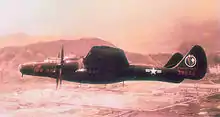
The unit was redesignated as the 347th Fighter Wing (All Weather) and reactivated in Japan on 20 February 1947 as part of Far East Air Forces 315th Composite Wing to perform air defense duties. The wing was assembled from three former Northrop F-61B Black Widow night fighter squadrons, the 6th, 418th, and 421st. The squadrons were redesignated the 339th, 4th, and 68th squadrons, respectively. In August 1948, their designations were changed to Fighter (All Weather) Squadron to more closely identify their mission.
The 4th Fighter (All Weather) Squadron was deployed and attached to the 51st Fighter Group at Kadena Air Base, Okinawa.
The useful life of the F-61 was extended due to the Air Force's problems in fielding a jet-powered night/all-weather fighter. The Curtiss XP-87/XF-87 Blackhawk was the planned replacement, however problems in development led the Black Widow to be replaced by another propeller-driven fighter, the North American F-82F/G Twin Mustang.
The Twin Mustangs started to arrive during mid-1949 and 1950. The 347th was the last active duty USAF unit to fly the Black Widow, the 339th FS retiring its last F-61 in May 1950, missing the Korean War by only a month.
Korean War
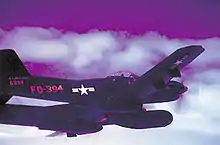
As the war in Korea began, on 24 June 1950 the 347th Fighter Wing was inactivated and the 347th Fighter Group's Twin Mustang squadrons were transferred to South Korea. They were the only fighter aircraft available with the range to cover the entire Korean peninsula.
The 339th Squadron was attached to the 8th Fighter Wing at Kimpo Airfield, near Seoul South Korea to stem the North Korean advance. The 68th Fighter (AW) Squadron was based at Itazuke, Japan. The 4th (AW) Squadron was reassigned to the provisional 6302d Air Base Group and provided air defense of Japan and the Ryukyu Islands.
The 347th Fighter Group provided fighter cover for the C-54 and C-47 transports flying in and out of Kimpo Airfield. On 27 June 1950, an F-82G (46–383) of the 68th Fighter (AW) Squadron flown by Lieut. William (Skeeter) Hudson (pilot) and Lieut. Carl Fraser (radar operator) shot down a North Korean Yak-7U (possibly a misidentified Yak-11). This was the first air-to-air kill of the Korean War, and, incidentally, the first aerial victory by the newly formed United States Air Force.
It is believed that Lt. Hudson was flying an F-82G named "Bucket of Bolts" (46–601) instead of his usual aircraft on that historic day. Later that same day, an F-82G (46–392) flown by Major James Little of the 339th Fighter (AW) Squadron of the 347th Fighter Group shot down a North Korean Yak-9. Records are unreliable, and some experts maintain that Major Little actually was the first to kill.
The 339th and 68th Fighter (AW) Squadrons served in South Korea until December 1950, being attached to the 8th FBW, 35th FIW, and 51st FIW. As more jets, especially the all-weather Lockheed F-94 Starfire, became available the F-82s were deligated to ground attack missions before eventually being withdrawn from the Korean Theater, modified, and reassigned to bomber escort duties at Ladd AFB, Alaska. With their F-82's reassigned to Alaska, the 347th Fighter Group was inactivated and stood down.
Japan
The 347th Tactical Fighter Wing was reactivated at Yokota Air Base, Japan in December 1967 as part of Fifth Air Force. In Japan, the wing performed tactical fighter training missions, aerial reconnaissance, and contingency operations. Its operational squadrons were the following:
- 34th Tactical Fighter: (Deployed June 1968 – March 1971)
- 35th Tactical Fighter: 10 June 1968 – 15 March 1971 (TC: GG, Red fin caps)
- 36th Tactical Fighter: 15 January 1968 – 15 May 1971. (TC: GL, Blue fin caps)
- 80th Tactical Fighter: 15 January 1968 – 15 February 1971 (TC: GR, Yellow fin caps)
- 556th Tactical Reconnaissance: 1 July 1968 – 15 May 1971 Martin EB/RB-57E Canberra, Lockheed C-130B-II, Sun Valley) (B-57 Tail Code: GT, C-130Bs uncoded)
The 35th, 36th, and 80th TFS were equipped with the McDonnell-Douglas F-4C Phantom IIs and flew tactical fighter training missions. The 556th flew various electronic warfare and special operations sorties of a classified nature. The 34th TFS was in a deployed status to the 388th TFW, Korat RTAFB, Thailand. 347th F-4C aircrews would rotate TDY to and from the 34th TFS. Squadron transferred permanently to the 388th TFW, March 1971.
In 1971 the US and Japan agreed that all combat squadrons based at Yokota were to be reassigned and Yokota became a non-flying station hosted by the 475th Air Base Wing. 35th TFS aircraft were transferred to 67th TFS/18th TFW, Kadena Air Base Okinawa. The 36th and 80th TFS aircraft were transferred to 3d TFW, Kusan AB, South Korea. The 554th TRS's B-57s were reassigned to the 363d TRW at Shaw AFB, South Carolina. The C-130s were retained at Yokota and reassigned to the incoming 475th Air Base Wing.
The 347th TFW was inactivated in place in May 1971 prior to reassignment to the United States.
Mountain Home AFB

The 347th was reactivated and reequipped with factory-fresh General Dynamics F-111F Aardvarks, replacing the 67th Tactical Reconnaissance Wing as host unit at Mountain Home AFB, Idaho in May 1971. Operational squadrons of the wing were:
- 391st Tactical Fighter (July 1971 – October 1972) (Tail Code: MO)
- 4589th Tactical Fighter (July 1971 – October 1971) (Tail Code: MP)
389th Tactical Fighter (October 1971 – October 1972) (Tail Code: MP/MO) - 4590th Tactical Fighter (July 1971 – June 1972) (Tail Code: MQ)
390th Tactical Fighter (June – October 1972) (Tail Code: MO)
The 4589th/4590th TFS were provisional units, pending the transfer of the 389th and 390th TFSs from the 12th and 366th TFWs in Southeast Asia. All three squadrons adopted the MO tail code under the common wing concept in June 1972.
The 347th had a short stay at Mountain Home, conducting F-111F training until October 1972, when it was replaced by the 366th TFW which moved from Takhli RTAFB, Thailand to Mountain Home. Upon its arrival, the 366th absorbed all the people and equipment of the 347th.
Takhli RTAFB
On 30 July 1973 the 347th Tactical Fighter Wing was reactivated at Takhli Royal Thai Air Force Base, Thailand, inheriting two squadrons of F-111As from the 474th Tactical Fighter Wing, which ended its TDY at Takhli from Nellis AFB, Nevada. These were:
- 428 Tactical Fighter (Tail Code: HG – Red Tail Fin)
- 429 Tactical Fighter (Tail Code: HG – Yellow Tail Fin)
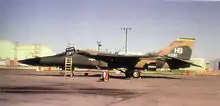
For a brief two-week period the 347th flew combat operations into Cambodia until 15 August, when the last wartime mission of the Vietnam Era was flown for final mission of Constant Guard. After the ceasefire, the wing was maintained in a combat-ready status for possible contingency actions.
During January 1974 the Secretary of Defense announced a realignment of Thailand resources, with the final pullout of air resources by the end of 1976. In June 1974, two F-111s from the 347th TFW flew from Takhli to Osan Air Base South Korea and conducted live weapons demonstrations for Republic of Korea and US officials at Nightmare Range.
Takhli RTAFB was returned to the Royal Thai Air Force in July 1974, with the 347th inactivating in place.
Korat RTAFB
With the return of Takhli to the Royal Thai Air Force, the two F-111 squadrons (428th, 429th TFS) of the 347th were transferred to Korat Royal Thai Air Force Base. The 347th TFW was activated in place on 12 July 1974.
At Korat, the 347th performed training readiness missions. It participated in the recovery of the SS Mayaguez, an American merchant ship, from the Khmer Rouge Cambodians, 13–14 May 1975.
On 30 June 1975, the two F-111A squadrons were inactivated. The aircraft were sent to the 422d Fighter Weapon Squadron at Nellis Air Force Base, Nevada. The 347th TFW was reassigned to Moody AFB, Georgia.
Moody AFB
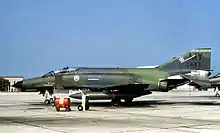
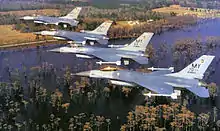
On 1 December 1975 the 347th Tactical Fighter Wing was reactivated at Moody AFB, Georgia as a tactical fighter wing under Tactical Air Command. Operational fighter squadrons at Moody were:
- 68th Tactical Fighter Squadron (Tail Code: MY, Red tail stripe)
- 69th Tactical Fighter Squadron (Tail Code: MY, Silver tail stripe)
- 70th Tactical Fighter Squadron (Tail Code: MY, Blue/White checkered tail stripe)
The 347th flew the McDonnell-Douglas F-4E until 1988, upgrading to the Block 15 General Dynamics F-16A/B. In 1990 the wing upgraded again to the Block 40 F-16C/D. Moody won the Commander-in-Chief's Installation Excellence Award for 1991, and the 1994 Verne Orr Award, which is presented by the Air Force Association to the unit that most effectively uses human resources to accomplish its mission. In June 1997, the 347th TFW was awarded the Air Force Outstanding Unit Award for the eighth time in its illustrious history.
On 1 October 1991, the 347th TFW was redesignated the 347th Fighter Wing. On 1 June 1992 the 347th FW was assigned to the newly activated Air Combat Command.
As a result of the August 1992 destruction of Homestead AFB Florida by Hurricane Andrew, the 31st Fighter Wing's 307th and 308th Fighter Squadrons were initially evacuated to Moody AFB prior to the hurricane making landfall. With Homstead unusable for an extended period after the hurricane, on 20 November the squadrons were permanently assigned to the 347th TFW. On 1 April 1994, the 308th FS was moved without personnel or equipment to the 56th Fighter Wing at Luke AFB, Arizona, replacing the 311th FS. The squadrons Block 40 F-16s were sent to USAFE.
On 1 July 1994, the Air Force redesignated the 347th Fighter Wing to the 347th Wing, a force projection, air/land composite wing. Squadrons of the 347th Wing were:
- 52d Airlift Squadron (C-130E) (green tail stripe – ROOS)
Transferred from inactivated 63d MAW, Norton AFB, California 1 May 1994. Was a C-141B squadron at Norton. - 68th Fighter Squadron (F-16C/D) (red tail stripe – LANCERS)
- 69th Fighter Squadron (F-16C/D) (black tail stripe – WEREWOLVES)
- 70th Fighter Squadron (A/OA – 10A) (blue/white tail stripe – WHITE KNIGHTS)
- 307th Fighter Squadron (F-16C/D) (black tail stripe – STINGERS)
The 307th FS was inactivated on 31 August 1995 when F-16 operations at Moody were reduced in size.
On 1 April 1997 the 347th Wing added a search-and-rescue component with the addition of the 41st Rescue Squadron with HH-60G helicopters and the 71st Rescue Squadron with specialized HC-130P aircraft from Patrick AFB, Florida. To make room for these squadrons, the 52d Airlift Squadron was inactivated, with its C-130s being transferred to the 71st RQS.
The F-16s of the 347th began to be transferred out as the "Composite Wing" concept ended at Moody. The 70th FS was inactivated on 30 June 2000. The 69th FS was inactivated on 2 February 2001, and the 68th FS was inactivated on 1 April. The F-16s were transferred to various active-duty, reserve, and Air National Guard squadrons both in the CONUS as well as overseas.
On 1 May 2001, the 347th Wing stood down as a composite wing and stood up as the 347th Rescue Wing, becoming the Air Force's only active-duty combat search and rescue wing. The 347th RQW was transferred from ACC to the Air Force Special Operations Command on 1 October 2003.
References
- See also Copeland, Larry (4 October 2003). "Ga. town can't forget 6 who died in Afghanistan". USA TODAY. Retrieved 17 April 2008.
 This article incorporates public domain material from the Air Force Historical Research Agency website http://www.afhra.af.mil/.
This article incorporates public domain material from the Air Force Historical Research Agency website http://www.afhra.af.mil/.- Some of this text in of this article was taken from pages on the Moody AFB website, which as a work of the U.S. Government is presumed to be a public domain resource.
- Davis. Larry (1996). F-82 Twin Mustang (Squadron/Signal Mini in Action Series Number 8). Carrollton, Texas: Squadron/Signal Publications. ISBN 0-89747-367-1.
- Maurer, Maurer (1983). Air Force Combat Units of World War II. Maxwell AFB, Alabama: Office of Air Force History. ISBN 0-89201-092-4.
- Martin, Patrick (1994). Tail Code: The Complete History of USAF Tactical Aircraft Tail Code Markings. Schiffer Military Aviation History. ISBN 0-88740-513-4.
- Mueller, Robert (1989). Active Air Force Bases Within the United States of America on 17 September 1982. USAF Reference Series, Maxwell AFB, Alabama: Office of Air Force History. ISBN 0-912799-53-6
- Pape, Garry R., Campbell, John M. and Donna (1991), Northrop P-61 Black Widow—The Complete History and Combat Record. St. Paul, Minnesota: Motorbooks International. ISBN 0-87938-509-X.
- Ravenstein, Charles A. (1984). Air Force Combat Wings Lineage and Honors Histories 1947–1977. Maxwell AFB, Alabama: Office of Air Force History. ISBN 0-912799-12-9.
- Rogers, Brian (2005). United States Air Force Unit Designations Since 1978. Hinkley, England: Midland Publications. ISBN 1-85780-197-0.
- Thompson, Warren (1995), Fighter Combat Over Korea, Part 1: First Kills, Wings of Fame, Aerospace Publishing ISBN 1-85532-115-7.
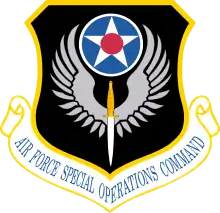
.jpg.webp)